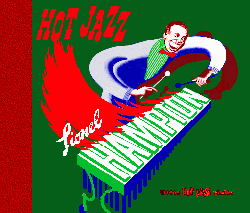
 |
Lionel Hampton |
 Lionel Hampton was born in Louisville, Kentucky on April 20, 1908. He was raised in Chicago, played drums in Chicago Defender Boys' band. Moved to California in 1928, played drums with the Paul Howard Orchestra, Eddie Barefield, and Les Hire. While Louis Armstrong was fronting the Hire band, Hampton picked up vibes; his first recorded solo on this instrument was "Memories of You," made with Louis in October of 1930.
Lionel Hampton was born in Louisville, Kentucky on April 20, 1908. He was raised in Chicago, played drums in Chicago Defender Boys' band. Moved to California in 1928, played drums with the Paul Howard Orchestra, Eddie Barefield, and Les Hire. While Louis Armstrong was fronting the Hire band, Hampton picked up vibes; his first recorded solo on this instrument was "Memories of You," made with Louis in October of 1930.
After four years with Hire, Hampton organized his own band to play at Sebastian's Cotton Club in Los Angeles. Benny Goodman heard him, used him on a record date with Teddy Wilson and Gene Krupa in August of 1936, and persuaded him to give up his band and go on the road with Goodman. From then until 1940, in addition to touring with the Goodman quartet on vibes (and occasionally subbing in the big band on drums), Hampton made a series of Victor records with pickup recording bands that achieved great prestige among collectors. Featured on these sessions were sidemen From almost every top name jazz band.
In September of 1940 Hampton fronted his own permanent orchestra. The band was an almost immediate success but did not record in its entirety until Christmas eve of 1941. The following May, Hampton recorded the first big band version of "Flyin' Home," which he had previously made with the Goodman sextet and with a ten-piece band on Victor. The new record was a colossal success and established Hampton's dominance in the big band field. Throughout the 1940s he went from success to success commercially, while hundreds of since-celebrated musicians passed through the ranks of the band, among them such men as Illinois Jacquet, Jack McVea, Dexter Cordon, Arnett Cobb on tenor saxes.
The Hampton band, operating on the premise that excitement was the main objective of jazz, gradually reduced the accent on musicianship, and by the early 1950s had become as much a rhythm-and-blues as a jazz attraction, with circus overtones; nevertheless, the band remained the medium for the introduction of many great jazz talents.
After taking part in the film "The Benny Goodman Story" in 1955, Hampton resumed touring and during 1956-60 the band spent a great deal of its time overseas, enjoying a spectacular success in Israel, also touring in Britain, the Continent, North Africa and Australia.
Hampton was the first jazz musician to feature the vibraharp vibraphone (popularly known as vibes). Although a wonderful beat and tremendous energy are the best-known qualities of his work, some of his finest records have been made at slower tempi and in groups other than his own big band. The orchestra recorded for Decca from 1941-47, later was heard on MGM. In 1953 Hampton started to record for Clef, mainly with small all-star groups assembled by Norman Granz; many of his LPs since then can be heard on the Verve label, though he has free-lanced.
Hampton occasionally plays piano in the "trigger-finger" style he originated, using his two forefingers as if they were vibraphone mallets and playing extremely fast single-note passages; he is also a heavy, enthusiastic drummer. His main place in jazz was made as a dynamic personality, operating best with harmonic and melodic simplicity, with the vibes as his real medium.
And to this day, the Hampton band is still on the road, and once a year, Lionel hosts the annual "Lionel Hampton Jazz Festival" in Moscow, Idaho on the campus of the University of Idaho were many new and old jazz greats assemble for concerts, workshops, clinics and competition.
Some of the information in this mini-bio were obtained from Leonard Feather's "Encyclopedia of Jazz", (1960; Bonanza Books, NY).